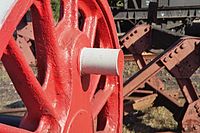Cones (technology)
A peg is an (often cylindrical or cuboid) extension of a component that is used to connect it to another component.
mechanical engineering
In mechanical engineering, a pin describes an offset end of an axis that can accommodate a bearing and serves as the center of a rotary movement . Such pins are made by turning off the raw axle and their dimensions are largely standardized . At the end of a shaft , on the other hand, the journal does not take a bearing, but a shaft-hub connection such as a feather key . The groove required for this is milled into the previously machined pin ; the length, width and depth of the groove are standardized, as is the associated pin. In watchmaking , tenons are rolled in a tenon roller wheelchair .
Crank pin

A crank pin is off the center of an axle. It takes a connecting rod or a connecting rod and thus ensures the crank drive . In the case of locomotives, this also connects coupling rods to the corresponding two wheel sets .
Wood processing
In the field of wood processing, a tenon denotes an offset end of a 2-part wood connection . Its counterpart in the connection is called a slot. Depending on the requirements or the design of the wood connection, the tenon can be made in different versions. Applications are e.g. B. Corner connections on wooden windows, framed doors and areas of timber or half-timbered construction.
literature
- Albert Neuburger: The technology in antiquity. R. Voigtländer Verlag, Leipzig 1919.
- Alfred Böge (Hrsg.): Vieweg manual mechanical engineering. Basics and applications of mechanical engineering, 18th revised and expanded edition, Friedrich Vieweg & Sohn Verlag, Wiesbaden 2007, ISBN 978-3-8348-0110-4 .
Web links
The term crank pin at Lueger: Lexicon of the entire technology (1904)


